Ore
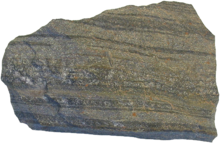
Iron ore (banded iron formation)
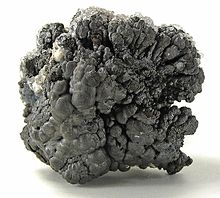
Manganese ore – psilomelane (size: 6.7 × 5.8 × 5.1 cm)
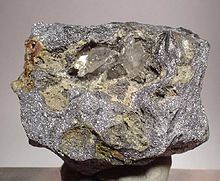
Lead ore – galena and anglesite (size: 4.8 × 4.0 × 3.0 cm)
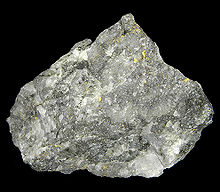
Gold ore (size: 7.5 × 6.1 × 4.1 cm)

Cart for carrying ore from a mine on display at the Historic Archive and Museum of Mining in Pachuca, Mexico
An ore is an occurrence of rock or sediment that contains sufficient minerals with economically important elements, typically metals, that can be economically extracted from the deposit.[1] The ores are extracted from the earth through mining; they are then refined (often via smelting) to extract the valuable element, or elements.
The ore grade, or concentration of an ore mineral or metal, as well as its form of occurrence, will directly affect the costs associated with mining the ore. The cost of extraction must thus be weighed against the metal value contained in the rock to determine what ore can be processed and what ore is of too low a grade to be worth mining. Metal ores are generally oxides, sulfides, silicates, or native metals (such as native copper) that are not commonly concentrated in the Earth's crust, or noble metals (not usually forming compounds) such as gold. The ores must be processed to extract the elements of interest from the waste rock and from the ore minerals. Ore bodies are formed by a variety of geological processes. The process of ore formation is called ore genesis.
Contents
1 Ore deposits
1.1 Classification
1.1.1 Hydrothermal epigenetic deposits
1.1.2 Granite related hydrothermal
1.1.3 Magmatic deposits
1.1.4 Volcanic-related deposits
1.1.5 Metamorphically reworked deposits
1.1.6 Carbonatite-alkaline igneous related
1.1.7 Sedimentary deposits
1.1.8 Sedimentary hydrothermal deposits
1.1.9 Astrobleme-related ores
2 Extraction
3 Trade
4 Important ore minerals
5 See also
6 References
7 Further reading
Ore deposits
An ore deposit is an accumulation of ore. This is distinct from a mineral resource as defined by the mineral resource classification criteria. An ore deposit is one occurrence of a particular ore type. Most ore deposits are named according to their location (for example, the Witwatersrand, South Africa), or after a discoverer (e.g. the kambalda nickel shoots are named after drillers), or after some whimsy, a historical figure, a prominent person, something from mythology (phoenix, kraken, serepentleopard, etc.) or the code name of the resource company which found it (e.g. MKD-5 is the in-house name for the Mount Keith nickel ).
Classification
Ore deposits are classified according to various criteria developed via the study of economic geology, or ore genesis. The classifications below are typical.
Hydrothermal epigenetic deposits
Mesothermal lode gold deposits, typified by the Golden Mile, Kalgoorlie
Archaean conglomerate hosted gold-uranium deposits, typified by Elliot Lake, Ontario, Canada and Witwatersrand, South Africa
Carlin–type gold deposits, including;
Epithermal stockwork vein deposits
- IOCG or iron oxide copper gold deposits, typified by the supergiant Olympic Dam Cu-Au-U deposit
Porphyry copper +/- gold +/- molybdenum +/- silver deposits- Intrusive-related copper-gold +/- (tin-tungsten), typified by the Tombstone, Arizona deposits
- Hydromagmatic magnetite iron ore deposits and skarns
Skarn ore deposits of copper, lead, zinc, tungsten, etcetera
Magmatic deposits
- Magmatic nickel-copper-iron-PGE deposits including
Cumulate vanadiferous or platinum-bearing magnetite or chromite- Cumulate hard-rock titanium (ilmenite) deposits
- Komatiite hosted Ni-Cu-PGE deposits
Subvolcanic feeder subtype, typified by Noril'sk-Talnakh and the Thompson Belt, Canada- Intrusive-related Ni-Cu-PGE, typified by Voisey's Bay, Canada and Jinchuan, China
Lateritic nickel ore deposits, examples include Goro and Acoje, (Philippines) and Ravensthorpe, Western Australia.
Volcanic hosted massive sulfide (VHMS) Cu-Pb-Zn including;- Examples include Teutonic Bore and Golden Grove, Western Australia
Besshi type- Kuroko type
- Examples include Teutonic Bore and Golden Grove, Western Australia
Metamorphically reworked deposits
- Podiform serpentinite-hosted paramagmatic iron oxide-chromite deposits, typified by Savage River, Tasmania iron ore, Coobina chromite deposit
Broken Hill Type Pb-Zn-Ag, considered to be a class of reworked SEDEX deposits
- Phosphorus-tantalite-vermiculite (Phalaborwa South Africa)
Rare earth elements – Mount Weld, Australia and Bayan Obo, Mongolia
Diatreme hosted diamond in kimberlite, lamproite or lamprophyre
Sedimentary deposits
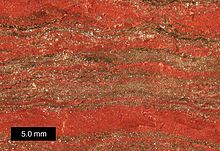
Magnified view of banded iron formation specimen from Upper Michigan. Scale bar is 5.0 mm.
Banded iron formation iron ore deposits, including
Channel-iron deposits or pisolite type iron ore
Heavy mineral sands ore deposits and other sand dune hosted deposits
Alluvial gold, diamond, tin, platinum or black sand deposits- Alluvial oxide zinc deposit type: sole example Skorpion Zinc
Sedimentary hydrothermal deposits
SEDEX
Lead-zinc-silver, typified by Red Dog, McArthur River, Mount Isa, etc.- Stratiform arkose-hosted and shale-hosted copper, typified by the Zambian copperbelt.
- Stratiform tungsten, typified by the Erzgebirge deposits, Czechoslovakia
- Exhalative spilite-chert hosted gold deposits
- Mississippi valley type (MVT) zinc-lead deposits
Hematite iron ore deposits of altered banded iron formation
Sudbury Basin nickel and copper, Ontario, Canada
Extraction

Some ore deposits in the world

Some additional ore deposits in the world
The basic extraction of ore deposits follows these steps:
Prospecting or exploration to find and then define the extent and value of ore where it is located ("ore body")- Conduct resource estimation to mathematically estimate the size and grade of the deposit
- Conduct a pre-feasibility study to determine the theoretical economics of the ore deposit. This identifies, early on, whether further investment in estimation and engineering studies is warranted and identifies key risks and areas for further work.
- Conduct a feasibility study to evaluate the financial viability, technical and financial risks and robustness of the project and make a decision as whether to develop or walk away from a proposed mine project. This includes mine planning to evaluate the economically recoverable portion of the deposit, the metallurgy and ore recoverability, marketability and payability of the ore concentrates, engineering, milling and infrastructure costs, finance and equity requirements and a cradle to grave analysis of the possible mine, from the initial excavation all the way through to reclamation.
- Development to create access to an ore body and building of mine plant and equipment
- The operation of the mine in an active sense
Reclamation to make land where a mine had been suitable for future use
Trade
Ores (metals) are traded internationally and comprise a sizeable portion of international trade in raw materials both in value and volume. This is because the worldwide distribution of ores is unequal and dislocated from locations of peak demand and from smelting infrastructure.
Most base metals (copper, lead, zinc, nickel) are traded internationally on the London Metal Exchange, with smaller stockpiles and metals exchanges monitored by the COMEX and NYMEX exchanges in the United States and the Shanghai Futures Exchange in China.
Iron ore is traded between customer and producer, though various benchmark prices are set quarterly between the major mining conglomerates and the major consumers, and this sets the stage for smaller participants.
Other, lesser, commodities do not have international clearing houses and benchmark prices, with most prices negotiated between suppliers and customers one-on-one. This generally makes determining the price of ores of this nature opaque and difficult. Such metals include lithium, niobium-tantalum, bismuth, antimony and rare earths. Most of these commodities are also dominated by one or two major suppliers with >60% of the world's reserves. The London Metal Exchange aims to add uranium to its list of metals on warrant.
The World Bank reports that China was the top importer of ores and metals in 2005 followed by the US and Japan.[citation needed]
Important ore minerals
Acanthite (cooled polymorph of Argentite): Ag2S for production of silver
Barite: BaSO4
Bauxite Al(OH)3 and AlOOH, dried to Al2O3 for production of aluminium
Beryl: Be3Al2(SiO3)6
Bornite: Cu5FeS4
Cassiterite: SnO2
Chalcocite: Cu2S for production of copper
Chalcopyrite: CuFeS2
Chromite: (Fe, Mg)Cr2O4 for production of chromium
Cinnabar: HgS for production of mercury
Cobaltite: (Co, Fe)AsS
Columbite-Tantalite or Coltan: (Fe, Mn)(Nb, Ta)2O6
Dolomite: CaMg(CO3)2
Galena: PbS
Native gold: Au, typically associated with quartz or as placer deposits
Hematite: Fe2O3
Ilmenite: FeTiO3
Magnetite: Fe3O4
Malachite: Cu2CO3(OH)2
Molybdenite: MoS2
Pentlandite: (Fe, Ni)9S8
Pyrolusite: MnO2
Scheelite: CaWO4
Sperrylite: PtAs2 for production of platinum
Sphalerite: ZnS
Uraninite (pitchblende): UO2 for production of metallic uranium
Wolframite: (Fe, Mn)WO4
See also
| Wikimedia Commons has media related to Ore. |
- Economic geology
- Mineral resource classification
- Ore genesis
- Petrology
- Froth Flotation
Extractive metallurgy (ore processing)
References
^ Guilbert, John M. and Charles F. Park, Jr. (1986) The Geology of Ore Deposits, W. H. Freeman, p. 1. .mw-parser-output cite.citationfont-style:inherit.mw-parser-output qquotes:"""""""'""'".mw-parser-output code.cs1-codecolor:inherit;background:inherit;border:inherit;padding:inherit.mw-parser-output .cs1-lock-free abackground:url("//upload.wikimedia.org/wikipedia/commons/thumb/6/65/Lock-green.svg/9px-Lock-green.svg.png")no-repeat;background-position:right .1em center.mw-parser-output .cs1-lock-limited a,.mw-parser-output .cs1-lock-registration abackground:url("//upload.wikimedia.org/wikipedia/commons/thumb/d/d6/Lock-gray-alt-2.svg/9px-Lock-gray-alt-2.svg.png")no-repeat;background-position:right .1em center.mw-parser-output .cs1-lock-subscription abackground:url("//upload.wikimedia.org/wikipedia/commons/thumb/a/aa/Lock-red-alt-2.svg/9px-Lock-red-alt-2.svg.png")no-repeat;background-position:right .1em center.mw-parser-output .cs1-subscription,.mw-parser-output .cs1-registrationcolor:#555.mw-parser-output .cs1-subscription span,.mw-parser-output .cs1-registration spanborder-bottom:1px dotted;cursor:help.mw-parser-output .cs1-hidden-errordisplay:none;font-size:100%.mw-parser-output .cs1-visible-errorfont-size:100%.mw-parser-output .cs1-subscription,.mw-parser-output .cs1-registration,.mw-parser-output .cs1-formatfont-size:95%.mw-parser-output .cs1-kern-left,.mw-parser-output .cs1-kern-wl-leftpadding-left:0.2em.mw-parser-output .cs1-kern-right,.mw-parser-output .cs1-kern-wl-rightpadding-right:0.2em
ISBN 0-7167-1456-6
Further reading
DILL, H.G. (2010) The “chessboard” classification scheme of mineral deposits: Mineralogy and geology from aluminum to zirconium, Earth-Science Reviews, Volume 100, Issue 1-4, June 2010, Pages 1-420